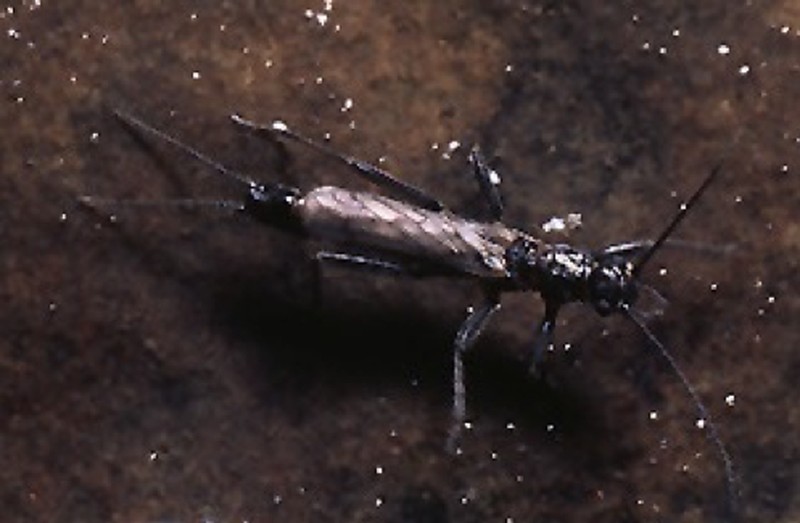Illinois Stonefly
Allocapnia illinoensis Frison, 1935
- Class
- Insecta (Insects)
- Family
- Capniidae
- State Protection
- Not Listed
Not listed or protected by New York State.
- Federal Protection
- Not Listed
- State Conservation Status Rank
- SNR
Not Ranked - State conservation status not yet assessed.
- Global Conservation Status Rank
- G3
Vulnerable globally - At moderate risk of extinction due to rarity or other factors; typically 80 or fewer populations or locations in the world, few individuals, restricted range, few remaining acres (or miles of stream), and/or recent and widespread declines.
Summary
Did you know?
Illinois Stoneflies remain active in the winter because they produce a special protein that keep them from freezing in the cold.
Conservation and Management
Conservation Strategies and Management Practices
Avoiding damming and flow alteration will help maintain favorable habitat for the Illinois Stonefly. Streams should be buffered to reduce agricultural and pesticide pollution. Reduction of road salt usage in transportation corridors near streams will benefit the conservation of this species (NYSDEC 2005).
Habitat
Habitat
Stoneflies require clean, fast flowing streams and rivers. Adults may be found climbing the trees during the winter and early spring months in the proximety of cold water streams.
Range
New York State Distribution
The distribution of this species is unknown in New York State. There is one historical occurrence of this species in New York in the Susquehanna watershed (Otsego County) and one recently recorded occurrence in the Lake Champlain watershed (Clinton County) (Myers et al. 2010).
Best Places to See
- (Clinton, Otsego Counties)
Identification Comments
Identifying Characteristics
Illinois stonefly larvae have two long filamentous cerci and have an elongated or flattened appearance. They also have long antennae, chewing mouthparts, gills on the abdominal segments, and pairs of thoracic wing pads. Adults are similar to the larvae except they have two pairs of wings folded over the abdomen and the gills are absent of vestigial (Hilsenhoff 1995).
Males of the Allocapina genus have varied and raised lobes on the dorsal abdominal segments (Frison 1929). Females are more difficult to distinguish.
Best Life Stage for Proper Identification
Adult
Diet
Illinois Stoneflies feed on the leaf litter and detritus that falls into the streams, especially in the fall.
Best Time to See
The Illinois Stonefly lives most of its life within the stream, around one to two years, and emerge as an adult in January thru April. Eggs are laid in the stream in the colder winter months, larvae hatch and feed on the allochthonous detritus found along the stream bottom. Allocapnia are univoltine, which means that they produce only one brood per season. During the spring and summer the larvae remain in diapause, a form of hibernation, in the
substrate of the stream (Hilsenhoff 1995).
- Present
- Active
- Larvae present and active
The time of year you would expect to find Illinois Stonefly present, active, and larvae present and active in New York.
Similar Species
- None (Allocapnia curiosa)
Allocapnia illinoensis is considered a northern relative of this species.
- None (Allocapnia maria)
Allocapnia illinoensis is considered a northern relative of this species.
- None (Allocapnia pechumani)
Allocapnia illinoensis is considered a northern relative of this species.
Illinois Stonefly Images
Taxonomy
Illinois Stonefly
Allocapnia illinoensis Frison, 1935
- Kingdom Animalia
- Phylum Arthropoda
(Mandibulates)
- Class Insecta
(Insects)
- Order Plecoptera
(Stoneflies)
- Family Capniidae
- Order Plecoptera
(Stoneflies)
- Class Insecta
(Insects)
- Phylum Arthropoda
(Mandibulates)
Additional Resources
References
Frison, T.H.. 1929. Fall and Winter Stoneflies, or Plecoptera, of Illinois. Schnepp and Barnes Printers, Springfield, Illinois.
Hilsenhoff, W.L.. 1995. Aquatic Insects of Wisconsin: Keys to Wisconsin Genera and Notes on Biology, Habitat, Distribution and Species. Publication Number 3 of the Natural History Museums Council. University of Wisconsin, Madison.
Myers, Luke, Timothy Mihuc, and Boris Kondratieff. 2010. Draft report: Mayflies (Ephemeroptera), Stoneflies (Plecoptera), and Caddisflies (Trichoptera) of the Upper Hudson, Lake Champlain, and Northeastern Lake Ontario watersheds (New York State): A baseline inventory with management considerations for SGCN and other rare and possibly imperiled species.
NatureServe. 2021. NatureServe Explorer: An online encyclopedia of life [web application]. NatureServe, Arlington, Virginia. Available http://www.natureserve.org/explorer. (Accessed: June 21, 2021).
New York Natural Heritage Program. 2024. New York Natural Heritage Program Databases. Albany, NY.
New York State Department of Environmental Conservation. 2015. State Wildlife Action Plan SGCN Stoneflies. Available at:<https://www.dec.ny.gov/docs/wildlife_pdf/sgcnstoneflies.pdf>{Accessed 21 June 2021].
Ross, H. H. and W. E. Ricker. 1971. The classification, evolution, and dispersal of the winter stonefly genus Allocapnia. Illinois Biological Monographs 45: 1-166.
Links
About This Guide
This guide was authored by: Lutz, Colleen M.
Information for this guide was last updated on: June 23, 2022
Please cite this page as:
New York Natural Heritage Program. 2024.
Online Conservation Guide for
Allocapnia illinoensis.
Available from: https://guides.nynhp.org/illinois-stonefly/.
Accessed July 27, 2024.
